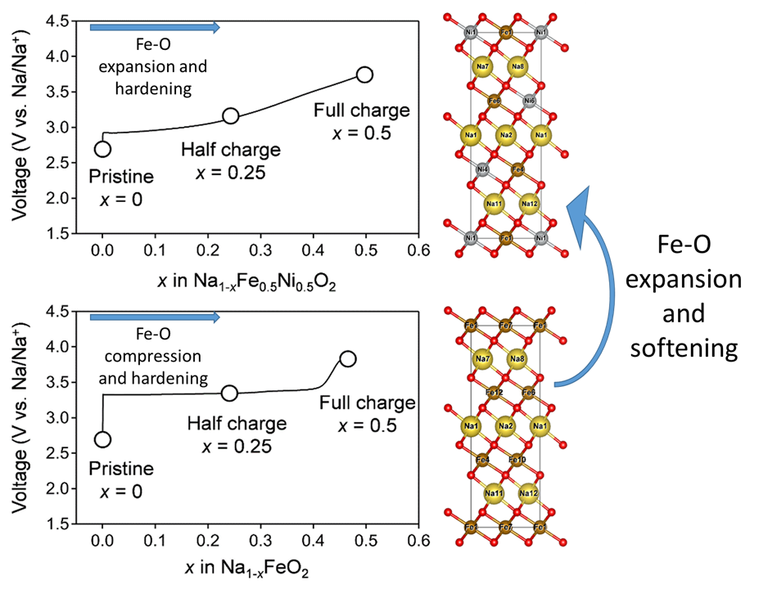Cerdanyola del Vallès, 21st March 2024 Synchrotron X-ray spectroscopies have played a key role in the continuous development and breakthroughs in battery science, thanks to their capability to provide accurate information on electronic structure of the redox active element, local structure, and morphological information. In particular, X-ray absorption spectroscopy (XAS) is more and more employed for addressing battery materials [1]. Generally, XAS studies on battery materials are performed at a single temperature as a function of charge, to access information on the electrochemical behavior and charge transfer mechanism during the intercalation or deintercalation process.
However, the fact that the charging/discharging process is expected to have direct influence on the bond length characteristics, strength and disorder, it is important to perform temperature dependence measurements to find a realistic correlation between the local structure and the battery characteristics. Indeed, temperature-dependent studies quantitatively allow to discriminate in between static and dynamic disorder, and to have direct access to the local force constant between the atom pairs. In the past the researcher team demonstrated the importance of the local atomic correlations as limiting factor in the ion diffusion and capacity of several electrodes: NaxCoO2 [2], and V2O5 [3], and lithium and manganese-rich NMC [4], and titanium based MXene-type [5].
More recently, the research team from the CLÆSS staff at ALBA, the University of Bialystok (Poland), the Institute of Energy and Climate Research (Germany), University of Twente (Netherlands), Waseda University and Tokyo University (Japan), Università di Roma La Sapienza (Italy) and the Sungkyunkwan University (Korea) reported the effect of nickel for iron substitution in the battery cathode on their electrochemical properties, demonstrating again the interest of the above described experimental approach.
This last scientific study aims to exploit the natural abundance of sodium. Sodium-ion batteries naturally deliver relatively lower energy density with respect to the Lithium-ion counterparts; however, their lower cost and fast charge/discharge ability make them a promising competitor to Lithium batteries to load level the intermittent power from renewable energy sources for smart grids or renewable power stations.
A crucial need for Sodium-ion batteries application is the optimization of the cathode material. The octahedral-type layered oxides with a composition of sodium and iron (NaFeO2) are a promising candidate for cathodes, even if the irreversible structural transition occurring during sodium ion extraction/insertion seriously hinders its practical application.
Scientists now reveal how partial replacement of iron by nickel significantly improves the electrochemical properties of Sodium-ion batteries. Even more, they identify the reasons of such improvement by accessing the details of the iron and nickel local electronic and structural properties by means of temperature dependent X-ray absorption and emission spectroscopies and spin-polarized density functional theory calculations.
The results identified some key parameters influencing the electrochemical properties of transition metal oxides exploited as cathode materials, which must be considered for the developments of more efficient cathodes. In particular, how the structure is affected by the iron substitution as well by the charge/discharge cycling, where the decrease of iron-oxygen covalency and the local disorder by partial substitution of iron with nickel seem at the origin of the improved performances.
In addition to the main scientific results, researchers highlight the importance of the exploited experimental approach. "Indeed, X-ray absorption spectroscopy is typically exploited at room temperature, while we demonstrated that the local static disorder and bond strength, parameters accessible by means of a temperature-dependent EXAFS study, affect the diffusion coefficients of the intercalating ions and the capacity of cathodes materials on several systems", explains Laura Simonelli, the proposer of such approach and studies [2-6] and the responsible of the CLÆSS beamline at ALBA.

Graphical abstract reporting the charge state investigated in the reported study and the material structure which have been exploited for the DFT calculation. Moreover, the figure summarizes the main results, related with the Fe-O local structural change, which occurs by partially substituting Ni for Fe and along the charge, and that correlate with the reported cathode performances.
References:
[1] Marcus Fehse, Antonella Iadecola, Laura Simonelli, Alessandro Longo and Lorenzo Stievano, Phys. Chem. Chem. Phys., 2021, 23, 23445–23465
[2] W. Olszewski, Marta Ávila Pérez, Carlo Marini, Eugenio Paris, Xianfen Wang, Tatsumi Iwao, Masashi Okubo, Atsuo Yamada, Takashi Mizokawa, Naurang Lal Saini, and Laura Simonelli , J. Phys. Chem. C 120 (2016) 4227–4232.
[3] W. Olszewski, Irene Isturiz, Carlo Marini, Marta Avila, Masashi Okubo, Huiqiao Li, Haoshen Zhou, Takashi Mizokawa, Naurang Lal Saini and Laura Simonelli, Phys. Chem. Chem. Phys. 20 (2018) 15288–15292.
[4] Shehab Ali, Wojciech Olszewski, Carlo Marini, Arefeh Kazzazi, Hyeongseon Choi, Matthias Kuenzel, Dominic Bresser, Stefano Passerini, DinoTonti, Laura Simonelli, Materials Today Physics 24 (2022) 100687
[5] Wojciech Olszewski, Carlo Marini, Satoshi Kajiyama, Masashi Okubo, Atsuo Yamada, Takashi Mizokawa, Naurang Lal Saini, Laura Simonelli, Phys. Chem. Chem. Phys., Phys. Chem. Chem. Phys., 2023,25, 3011-3019
[6] Wojciech Olszewski, Sourav Baiju, Payam Kaghazchi, Carlo Marini, Benoit Mortemard de Boisse, Masashi Okubo, Atsuo Yamada, Takashi Mizokawa, Naurang Lal Saini, Laura Simonelli, Materials Today Energy 40, 2024, 101519




